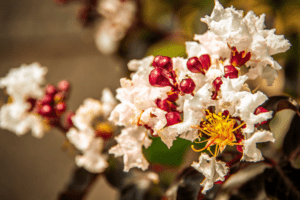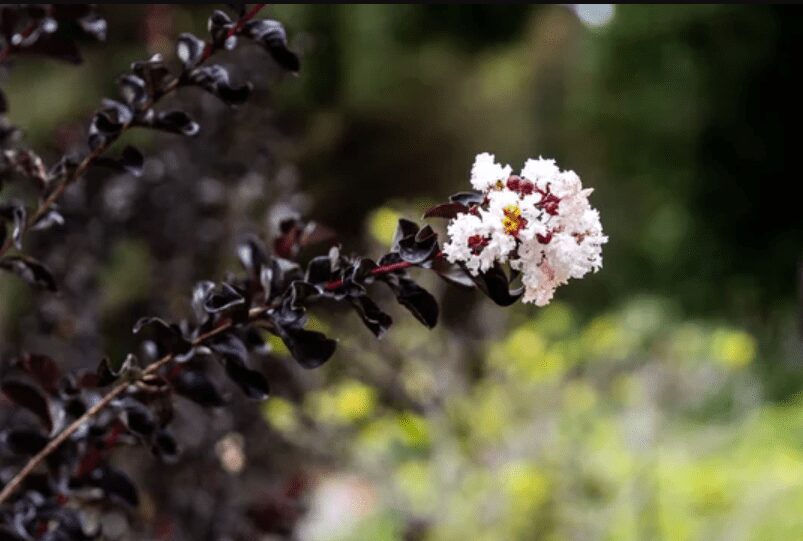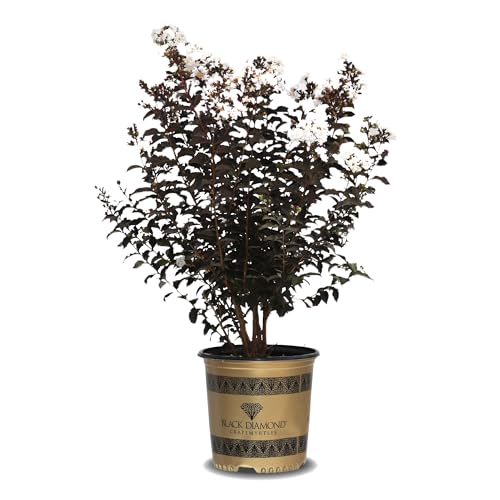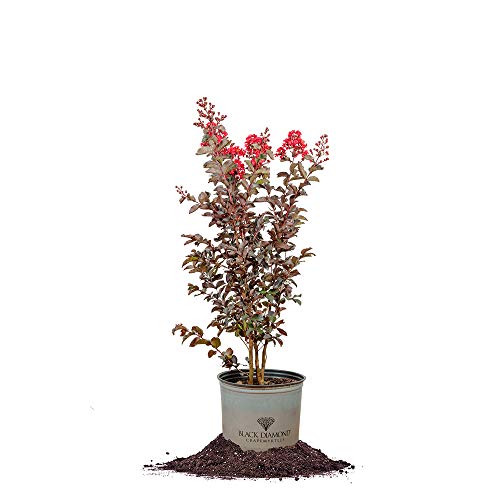Captivate your neighbors and create a breathtaking focal point in your yard with the mesmerizing Black Diamond Crape Myrtles series. Renowned for their deep purple-to-black foliage that sets a dramatic stage for vibrant summer blooms, these dwarf crape myrtles offer a unique and low-maintenance addition to any landscape.
Blooming Beauties: A Look at Black Diamond Crape Myrtle Varieties
Black Diamond Crape Myrtles come in a delightful array of colors, each boasting its personality. Let’s delve into the world of these captivating varieties:
-
Black Diamond Best Red

This showstopper lives up to its name with fiery red blooms that erupt against the dark foliage. Its moderate growth rate (around 12 inches per year) and mature size of 10-12 feet make it ideal for smaller gardens.
-
Black Diamond Blush

Softness and elegance define this variety. Delicate pink blossoms dance against the near-black leaves, creating a romantic atmosphere. Black Diamond Blush maintains a bushier form, reaching a height of 8-10 feet at maturity.
-
Black Diamond Crimson Red

This vibrant option boasts the deepest red blooms among the Black Diamond series. Its compact, bushy growth habit makes it perfect for containers or smaller landscapes. Crimson Red typically matures around 8-10 feet tall.
-
Black Diamond Mystic Magenta

Prepare to be mesmerized by the intense magenta flowers of this profuse bloomer. Mystic Magenta displays the highest tolerance for shade among Black Diamond varieties and maintains a bushier form, reaching 8-10 feet at maturity.
-
Black Diamond Pure White

Look no further than Pure White for a touch of serenity. Crisp white blooms elegantly contrast against the dark foliage, creating a sophisticated focal point. This variety grows moderately, reaching 10-12 feet at maturity.
Firstly, their striking, dark foliage and vibrant flowers make them an eye-catching addition to any garden or landscape. They are often used as a focal point or to add color and interest to an area.
Secondly, Black Diamond Crape Myrtles are relatively low-maintenance and are tolerant of heat, drought, and disease. This makes them ideal for gardeners who want a beautiful and easy-to-care-for tree.
Finally, Black Diamond Crape Myrtles are relatively small and compact, which makes them well-suited for smaller gardens or as a container plants. They are also available in a range of sizes, from small shrubs to larger trees, which gives gardeners a lot of flexibility in how they use them in their landscapes.
History and Origin of Black Diamond Crape Myrtles
How were they created?
However, it is known that the Black Diamond variety was selectively bred from other crape myrtle varieties with desirable traits, such as dark foliage and vibrant blooms.
The process likely involved cross-pollination, in which the pollen from one plant is transferred to the flowers of another, resulting in new seedlings with the desired characteristics.
Over time, the most promising seedlings were selected and further propagated to create a stable and uniform plant variety. This selective breeding and propagation process has been used for centuries to create new plant varieties with desirable traits and is a common practice in horticulture.
Who developed the first Black Diamond Crape Myrtle?
Characteristics of Black Diamond Crape Myrtles
Growth habit
The trees have a multi-stemmed, upright growth habit with a rounded or vase-shaped canopy. They produce dark green leaves that are typically 1 to 2 inches (2.5 to 5 centimeters) long, and the new growth has a reddish tint. The Black Diamond variety is known for its striking, almost black foliage, which provides a dramatic backdrop for the vibrant flowers.
Black Diamond Crape Myrtles bloom in mid to late summer and produce large clusters of deep red or pink flowers. The flowers are typically 1 to 2 inches (2.5 to 5 centimeters) in diameter and have a crepe-paper-like texture. They are followed by small, brown capsules that contain the tree’s seeds.
Overall, the growth habit of Black Diamond Crape Myrtles is relatively low-maintenance, and they are known for their drought and disease tolerance. However, like all trees, they will benefit from regular pruning and maintenance to promote healthy growth and maintain their shape.
Disease resistance
Powdery mildew is a fungal disease that causes a white or grayish powder to develop on the leaves and other plant parts. It can weaken the plant and make it more susceptible to other diseases and pests. Leaf spot is another fungal disease that causes circular or irregular spots to develop on the leaves, which can eventually cause the leaves to drop off.
Black Diamond Crape Myrtles also tolerates heat and drought, everyday stresses that can weaken plants and make them more susceptible to disease. However, like all trees, they may still be vulnerable to other pests and diseases, especially if they are stressed or not correctly cared for.
Regular maintenance, such as pruning, watering, and fertilization, can help to promote healthy growth and reduce the risk of disease.
Beyond the Beauty: Benefits of Black Diamond Crape Myrtles
Black Diamond Crape Myrtles offer more than just stunning aesthetics. Here’s what makes them a gardener’s delight:
- Compact Size: Perfectly suited for smaller yards or urban gardens, these dwarf trees won’t overpower your landscape.
- Low Maintenance: Enjoy vibrant blooms with minimal effort. Black Diamond Crape Myrtles are drought tolerant once established and require minimal pruning.
- Disease Resistant: These resilient trees are naturally resistant to powdery mildew, a common concern with crape myrtles.
- Long Bloom Time: Revel in a dazzling display of color from late spring all the way until frost.
Planting and Care Tips for Black Diamond Crape Myrtles
To ensure your Black Diamond Crape Myrtles thrive, plant them in a location receiving full sun and well-drained soil. Water them deeply twice a week for the first few months, then reduce watering to once a week during dry periods. Apply a slow-release fertilizer in spring to encourage healthy growth and vibrant blooms.
Where to Find Black Diamond Crape Myrtles
Black Diamond Crape Myrtles are becoming increasingly popular. Check with your local nurseries or garden centers to find these unique beauties.
Frequently Asked Questions (FAQs)
- Are Black Diamond Crape Myrtles suitable for small gardens?
Yes, Black Diamond Crape Myrtles are suitable for small gardens, as they have a compact growth habit and can be pruned to maintain a smaller size. However, it’s essential to choose a planting location that allows the tree enough space to grow and bloom.
- How often should I fertilize my Black Diamond Crape Myrtles?
It would be best if you fertilized your Black Diamond Crape Myrtles once a year in the spring. Use a balanced fertilizer that is specifically formulated for flowering trees and follow the manufacturer’s instructions for application rates.
- Can Black Diamond Crape Myrtles be grown in containers?
Yes, Black Diamond Crape Myrtles can be grown in containers, but choosing a large container allows for adequate root growth and drainage is essential. Use a well-draining potting mix and water the tree regularly to prevent it from drying out.
- How tall do Black Diamond Crape Myrtles grow?
Black Diamond Crape Myrtles typically grow between 10-12 feet tall, but can reach up to 20 feet in ideal growing conditions. However, the tree’s height can be controlled through regular pruning.
- Do Black Diamond Crape Myrtles attract bees or other insects?
Black Diamond Crape Myrtles attract bees, butterflies, and other pollinators with colorful blooms. However, they are not typically considered a significant attractant for pests or insects.
Conclusion
In conclusion, Black Diamond Crape Myrtles are a stunning and versatile tree that can add color and beauty to any garden. They are prized for their dark, almost black foliage and vibrant, long-lasting blooms.
They can thrive in various climates and soil conditions with proper care and attention, making them an excellent choice for gardeners of all levels. Black Diamond Crape Myrtles will dramatically impact any landscape, whether planted as a specimen tree, hedge, or mass planting.
Last update on 2024-07-26 / Affiliate links / Images from Amazon Product Advertising API





























